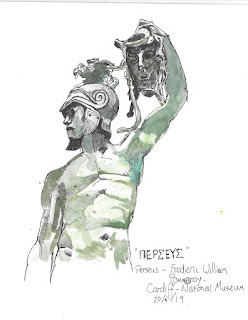My Urban Sketching Journey, and a few simple
lessons I’ve learned along the way
My urban sketching journey began in a funny kind of
way. I’ve always dabbled in sketching, and then in 2015 I joined a local art
group on a whim, and began painting in acrylics. I’m no great shakes as an
artist, but hey, I found it’s something I really enjoyed, and so when, in 2016,
I went to visit in-laws in the Alicante area in Spain I took my paints and
brushes with me.
I
didn’t often paint en plein air at that time, but I wanted to give it a try,
and I painted this picture of the local Cerveceria – bar to you and me. I used
a pad of acrylic paper, which I haven’t used very often. Using acrylics in
Spain in the height of summer is an interesting experience – they dry quickly
enough as it is, but they dry much quicker there. Anyway, I was pretty pleased
with the painting – it doesn’t take a great deal to make me happy, And I posted
it to an online forum. One of the comments that came back was that the person
who made the comment was thinking of trying urban sketching himself. To which I
replied – Urban what? – and that’s how I first came to learn of urban
sketching. If you want to get right down to basics, urban sketching is
just giving a name to something that loads of people have been doing for a long
time – sketching the world around them. As a movement, it began in Canada, as a
group of sketchers in an online forum “for all sketchers out there who love to draw the cities where
they live and visit, from the window of their homes, from a cafe, at a park,
standing by a street corner.” I suppose that the big difference between this
and the thousands of people who had already been doing this themselves was the
idea of a community, and the use of the internet – Facebook, blogs etc, - as a
forum and gallery.
What is the Urban Sketching Manifesto?
Basically, it’s the agreed set of rules and
standards which true Urban Sketchers live by. It states : -
- “We draw on location, indoors or out,
capturing what we see from direct observation.
- Our drawings tell the story of our
surroundings, the places we live and where we travel.
- Our drawings are a record of time and
place.
- We are truthful to the scenes we witness.
- We use any kind of media and cherish our
individual styles.
- We support each other and draw together.
- We share our drawings online.
- We show the world, one drawing at a
time. “
You’ll
notice that there’s nothing there which speaks about your ability as a
sketcher, or the quality of the work you produce. In my experience, urban
sketchers genuinely value every sketch each other produces. There’s no
stipulation on the media or methods you have to use to produce your sketches,
only that you try to do them on the spot.
I
started
urban sketching making a promise I couldn’t keep. I promised myself to make at
least one sketch every day. Now, there’s nothing wrong with this idea, but in
practice I found it difficult. The picture opposite is a vase of lilies, which
was on my telephone table on the first day of my urban sketching journey.
*There’s nothing wrong with
sketching everyday things all around you, especially when you’re starting out
and trying to build up your confidence.
My earliest
sketches were all in ordinary HB pencil, like this, and I don’t think that
there’s anything wrong with using pencil. It has the advantage that you can
create much more subtle shading effects with it than you can with pen. However,
I did want eventually to start using something which made more of a contrast
with the white paper.
*You can use whatever medium you
like. It’s worth trying a few different ways to get an idea what you’re really
comfortable with, and what you get your best results from.
During the
summer of 2016 I progressed from just taking advantage of whatever happened to
be around, to actively going out and looking for sketching opportunities.
This is one
of the sketches I made at this time. It wasn’t very far from home – this statue
is a war memorial in the nearest park to my home. It was while I was sketching
this, sitting on a nearby bench, when I had my first interaction with a member of
the public while I was sketching. A young lad on his bike came over, had a good
old look, which I facilitated by holding the sketchbook up for his inspection,
then said, “Hmm, you quite a good drawrer, ain’t you?” I’ve had wore
compliments than that in my life.
* You can find inspiration all
around you – you don’t necessarily have to go very far from home all the time.
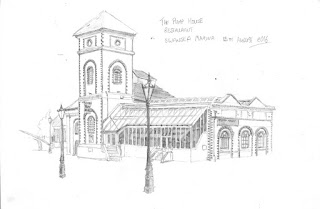 This one,
made a few days later, was one of my first urban sketches of a building. This
is the Pump House Restaurant in Swansea Marina – in a previous life it was the
Pumping House of Swansea Docks. While making this and the previous sketch I
found that I actually enjoy interacting with passers by while I’m sketching. I
rather like people having a look at a sketch while I’m making it, even if it
isn’t working out or it isn’t very good.
*In my experience, if you respond
to people who seem interested in your sketches in a positive way, they will
respond in a positive way back to you.
I’m glad that
I did these few sketches in public when I did, because towards the end of
August of 2016 I went to Ieper to visit the grave of my great grandfather, who
was killed in the Battle of Passchendaele. I’m not sure otherwise that I would
have plucked up the nerve to sit in public and produce this sketch of the
famous Cloth Hall, and another of the equally famous Menin Gate.
I think it’s
a good idea to look after your sketches and keep them safe, and look back at
them from time to time. The received wisdom is that if you keep sketching, you
will get better and better.
*If you keep your sketches you can
certainly look back and see how your style has evolved.
This one,
made a few days later, was one of my first urban sketches of a building. This
is the Pump House Restaurant in Swansea Marina – in a previous life it was the
Pumping House of Swansea Docks. While making this and the previous sketch I
found that I actually enjoy interacting with passers by while I’m sketching. I
rather like people having a look at a sketch while I’m making it, even if it
isn’t working out or it isn’t very good.
*In my experience, if you respond
to people who seem interested in your sketches in a positive way, they will
respond in a positive way back to you.
I’m glad that
I did these few sketches in public when I did, because towards the end of
August of 2016 I went to Ieper to visit the grave of my great grandfather, who
was killed in the Battle of Passchendaele. I’m not sure otherwise that I would
have plucked up the nerve to sit in public and produce this sketch of the
famous Cloth Hall, and another of the equally famous Menin Gate.
I think it’s
a good idea to look after your sketches and keep them safe, and look back at
them from time to time. The received wisdom is that if you keep sketching, you
will get better and better.
*If you keep your sketches you can
certainly look back and see how your style has evolved.
I
f I sketched
the Cloth Hall again now, two years later, then I’d do it differently. Not
necessarily much better, but just differently.
This is one
of the worst urban sketches I’ve made since I started, but it’s pretty
important to me. For
this is the first pen sketch I made. I made it in Brussels
airport, on my return from Ieper. Now, even though it claimed to be a sketching
pen, its tip was far too thick, and the ink seeped into the paper.
Nevertheless, simply working out what was wrong with this sketch, and with the
pen with which I made it was a step in the right direction to getting a pen
which I did want to work with.
* Even though you might think a
particular sketch is a failure, chances are there will be something you can
learn from it. So don’t throw it away – it has value.
After finding
a pen I liked, I pretty much carry the same things in my pack whenever I go out
sketching.
My basic equipment consists of one sketching pen, and an A5 sized sketch book,
but this is the stuff I have with me all the time, in case an opportunity for
an unplanned sketch presents itself. For a sketching trip I carry a pack of
sketching pens, an A4 sketchbook and an A5 sketchbook, a very small set of half
pan watercolour paints, a small bottle of water, and two paintbrushes. That’s
plenty, it’s not too onerous to carry round, and gives me plenty of options
about how I want to make my sketch. I could go even lighter if I carried a
waterbrush instead of the bottle, but I prefer using water bottle and
traditional brush.
As for clothing - well, it's a
matter of common sense. There's no such thing as bad weather, only
inappropriate clothing, as they say. As a rule of
thumb, you need to wear
warmer clothes in winter than you do in summer. Even in summer you're well
advised to carry a light waterproof in your pack, bearing in mind how
changeable the great British weather can be. Think in terms of what is going to
be most comfortable for you - nobody says that you have to suffer for your art.
On a personal level, I have a particular flat cap that I like to wear when I'm
sketching outside - keeps the rain and the cold out nicely during the
winter.
* When it comes to sketching, a
little equipment can go a long way. As a rough rule of thumb, aim to travel
light. If you don’t need to carry it around in your pack, then don’t.
I continued
sketching at weekends throught the Autumn and into the winter. This next sketch
is one of the first that I did with a sketching pen that I felt really
comfortable with. It shows part of the Pierhead building in Cardiff, a striking
red building faced with glazed terracotta tiles. It was opened right at the end
of the 19th century as headquarters of the Bute Dock Company, and is
now used by the National Assembly.
* When you sketch a building, or a
piece of sculpture, or an object for the first time, you end up looking at it
far more closely than you would otherwise have done, and this is often very
rewarding.
During the
early Spring of 2017 I could feel that things were not right with me, and I was
actually diagnosed as suffering from clinical depression. I was signed off work
for two months, and during that time I would say that medication played the
biggest and most important part in my recovery. However sketching played its
part as well. In order to sketch, I had to go out and find something to sketch.
That was positive. Then making the sketch would involve sitting down, and
becoming totally absorbed in something other than myself for however long it
took to draw it. That’s never a bad thing, in my opinion. Since returning to
work in May I’ve had one day off with illness – man flu as it happens – and I
don’t want to take any more time thank you very much. However depression is a
funny beast. I don’t know whether it’s like alcoholism which stays with you for
life, where you can be dry for years, but if you took another drink it could
start you off again, or whether it is something which will eventually fade out
of my life for good. I don’t know. I tend to think of it as being like a little
demon on my shoulder, whispering bad things to me whenever it thinks I will
listen. (I don’t actually hear voices. This is a metaphor.) The key is tuning
it out, which is easier to do at some times than at others. But sketching
definitely helps.
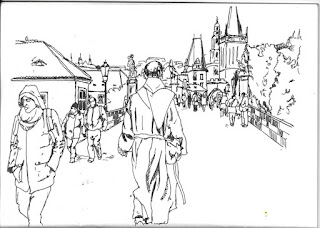
Two weeks out
of the 8 during which I was off work were actually my Easter holidays. I had
booked a short city break in Prague, where sketching was on the agenda as well
as sightseeing. A delegation of my family all sat me down, and drilled it into
me that actually, this was exactly the sort of thing I needed. And looking
back, I think that they were right. I made quite a lot of sketches while I was
in Prague. In particular I love the sketch directly on the left. I made this
one on the famous Charles Bridge across the river Vltava. I was crossing, and
this monk passed in front of me. I whipped out my book and pen, and very
quickly sketched in his outline and a few shadows. Then, when he’d gone, I just
picked on other figures as they approached me and added them to build up the
scene. They were all there, just not at the same time, which makes this a
composite sketch. Then, finally, I sketched in the bridge details and the
houses – which don’t tend to move around so much as people do.
* Any sketch has its own value,
but there’s something special about sketches which tell a story.
Not every
sketch I made in Prague does tell a story. Producing this kind of picture is a
skill I’ve yet to master, to be honest. Most of the sketches were just of
buildings which I liked. As far as I know there’s nothing particularly special
about this Church, which is fairly close to Wenceslaus Square. I just liked it,
and so I sketched it while I was sitting on a bench by the street market.
The other
Prague sketch which maybe tells a wee bit of a story is the sketch that I made
of the Tramway café. Prague has great trams – and if there’s one thing I do
like it’s a good tram, and two older trams have been parked in Wenceslaus
Square, and some clever entrepreneur has made a café out of the two of them.
Now, to be honest, the cup of coffee that I bought there was certainly the most
expensive that I bought in Prague, certainly not the best tasting, and
certainly brought to me by the most surly waiter I met in Prague. Still, I
didn’t make a fuss, since I felt that buying the coffee entitled me to sit on
the tables outside the tram itself, and make this sketch. I look at the
sketches that I made in Prague, and at least part of me thinks that if I hadn’t
made the sketched while I was there, I wouldn’t probably have realised that I
did actually enjoy the trip, and that it did help me. I was into my 4th
week on medication while I was there, and it had the effect of calming me, but
at the same time distancing me from what was happening. In a way it was a
little bit like watching a video of myself doing all those things. But the sketches
helped. That’s a fact.
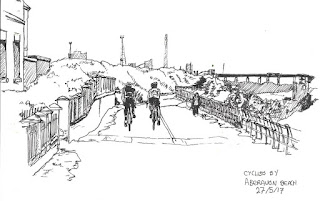
As I
recovered, and felt able to go back to work, I wanted to continue with my sketching.
Every weekend, I would set out with my pad, and try to capture something which
showed an aspect of Port Talbot, the town I live in. This is one of my
favourites, because although it looks relatively simple, it was quite a
difficult sketch to make. I had to go very quickly to get the cyclists
down in outline before they disappeared, and then filled in some of the dark
patches from memory. The lady with the dog thankfully didn’t move anything like
as fast. Looking at it now, I can see how I was developing into sketching whole
scenes rather than single buildings.
* If you challenge yourself from
time to time, it won’t always come off, but when it does, it feels great. Even
if it doesn’t you can still learn something from it.
Speaking of
challenges, when I realised that I’d made over 50 sketches of Port Talbot, I
challenged myself to make this into a hundred. Challenging yourself is not
necessarily everyone’s cup of tea, but I found that having a focus like this
made me more likely to get out and look for different aspects of the town that
I could try to sketch. I even created a blog called “100 Faces of Port Talbot”
to showcase the sketches.
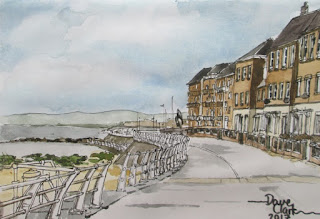
I think I
learned two main lessons from the challenge. I’d never really tried to get to
grips with using colour in sketches before this. My earlier attempts at line
and wash, were frustrating. When I make a sketch with a pen, much of the time
it ends up looking the way I want it to look, or a way that I’m happy with it
looking. I struggle with colour, and when I use watercolour, it rarely ends up
looking anything like I intended. Still simple persistence meant that I could,
after a time, produce something like the picture on the right which actually
looks a bit like the place its supposed to. The urge to try to use colour came
when I was chatting to the Head of Art at work, who mentioned that he’d seen
the sketches in “100 Faces of Port Talbot” and suggested I might like to try
using watercolour washes, as in his opinion I might be able to bring a whole
other dimension to my sketching if I did.
* Encourage criticism and advice.
It can really help you by pointing out things you hadn’t thought about
before.
By the start
of the summer holidays towards the end of July I could, on a good day, produce
something like the next sketch, of which I’m really rather proud. It shows the
Masonic Hall and various buildings around it in the centre of Port Talbot, and
I think that I just spent a bit more time than normal really looking at the
colours. It also helps I think that I didn’t do too much with the pen and ink
before I started applying the watercolour.
One other
thing you might have noticed is that I’ve written quite a bit more on the
picture than I had been doing previously. This came about throught the blog
really. One of the things I really enjoyed about making the blog was writing
the text to go with each picture, explaining what it was, what it had to do
with Port Talbot, the context in which I made the sketch etc. This has begun
leaking it’s way onto the pictures themselves.
The summer of
2017 marked both a return to European travel, and the first anniversary of my
making the painting which led to the start of my journey. I made quite a few
sketches in both Alicante and Berlin, lots of them of nice buildings, but not
all of them.
The latest
step in my journey has been joining the South Wales Urban Sketching Group. We
have a Facebook account, where we can display our work to a wider audience, and
meet once a month for a ‘sketchcrawl’. Basically we meet at a venue, then go
off and sketch for a couple of hours, coming back together to meet and share
work. I don’t need any excuse to sketch, but if I did, then this would provide
it. This picture of the statue of Perseus and another of a stuffed buzzard were
both made in my first sketchcrawl in January of 2018, over a period of a couple
of hours in the National Museum of Wales in Cardiff.
* If you enjoy urban sketching
anyway, joining a group is a good way to enhance that enjoyment. You’ll get
support, encouragement, and good advice.
So, coming
bang up to date, in less than 2 years, urban sketching has given me a huge
amount of pleasure, and contributed to an improvement in my mental health. It’s
just enjoyment for me, and I don’t look on it as some kind of competition,
either against somebody else or myself. Yes, I’d like to get better at it –
wouldn’t we all – but I’m never going to beat myself up over it.
I am trying
to focus more on figures than I’ve done in the past. With a couple of
noticeable
exceptions, like the monk sketch, when I have included figures in a
sketch they’ve tended to be small silhouettes – for example in this picture I
sketched in Prague. As you can see, they definitely add to the sketch, but they
don’t really add much to the ‘story’ of the picture, if indeed there is one.
Still, if I think about the way that the picture would have looked if I hadn't
included the figures, then it was at least an indication to me that I should be
thinking of integrating figures into my sketches.
Part of my
difficulty is that I get hung up on detail. That’s not a problem when you’re
sketching buildings, or statues, or stuffed birds, or anything which doesn’t
move around a lot. However people don’t stay still, so you really have to move
quickly to capture them. The sketch on the left is one that I made in Alicante
Airport in the summer of 2017. If I look at it critically, then I can say that it’s
not quite as successful as I would have liked. My original purpose was to focus
on the figures sitting in front of me.
They’re there, but they’re pretty loose
in execution. This is highlighted by the way I sketched in the details behind
and around them. If I’d taken a looser approach to putting in the surroundings,
and got less hung up on detail rather than just suggestion, then maybe the
figures would work a little better. As I’ve tried to say in this article, it’s
all part of a learning process.
More recently
I made a sketch while I was waiting to pick up my wife from the Arrivals in
Cardiff airport. This struck me as a sketching opportunity, and I zeroed in on
some of the figures in
the Costa Coffee concession. I sketched the figures in
extremely quickly – lightning fast for me, in fact, and then added just a few
details of the background. It’s far more impressionistic and less detailed than
the sketches I normally produce, but that’s not necessarily a weakness.
I’ll finish
with a list of questions. These are the questions that I haven’t already
answered, which I think that the 2016 me, who knew nothing about Urban
Sketching before that comment in the online forum, might have asked.
*
Do you have to have any qualifications or skill?
No, of course
not. I haven’t had a proper Art lesson since I was 13, and have no
qualifications whatsoever. This is about doing something for pleasure and
personal fulfillment. It isn’t a competition.
*
What can you draw for an urban sketch?
Anything you
like. If you can see it, sketch it. I really like buildings and street scenes,
you might like something else. There’s no rules – go for it.
*
Do you have to draw on the spot, or can you take a photograph and sketch it
later?
If you want
to call yourself an Urban Sketcher, then you have to get into the habit of
drawing on the spot. Think of it this way. If you take a photograph of a scene,
and then sketch from the photograph later, then the camera has already done a
lot of the work for you. It’s decided the angles, and it’s done the work of
translating a 3D scene into a 2D image, which you’d have to do for yourself on
the spot, and which is a skill you should aim to develop. Personally, I don’t think
there’s anything wrong with practising by making sketches from photographs.
This can help to develop your skill, style and draughtsmanship, but it’s not
the same as making a unique sketch on the spot, and this should be something
you aim to do as often as possible.
*
Do you have to join a group?
No. It’s your
choice. I’ve already listed some of the benefits, but if urban sketching is a
little corner of your life you want to keep to yourself, then good luck to you.
*
How can I improve my sketches?
Most
importantly, keep sketching. In his book about the importance of practice,
Matthew Syed explained that you really need 10,000 hours of practice to really
master a skill. That’s a lot of sketching expeditions.
I
f you’re
serious about improving, then it can help to have a critical friend. That would
be someone you can trust, to whom you can show your sketches. A fresh eye can
often notice things which you haven’t seen for yourself, especially if your critical
friend is another sketcher. At the very least, look critically at your own
sketches. If you're 100% happy with them, that's fantastic. If not, then try to
figure out why. For example, on a sketching expedition a couple of weeks ago to
the Glynn Vivian Art Gallery in Swansea I made these two sketches on a separate
pages: -
Now, as sketches there's nothing that wrong with either of them. The
problem was that I only managed to make the two of them in about 2 and a half hours,
and on a typical sketchcrawl I wouldn't have a lot more time than that.
So, the
obvious thing to do the next time I went on a sketch crawl, I thought, would be
to try to make more sketches, not quite as detailed, in the same time. A couple
of weeks later I made this set of sketches on a double page of my book during a
visit to Swansea Museum. In terms of what I didn't like about the
sketches above, this was an improvement. I picked no fewer than six different
exhibits in the museum, and sketched them within the three hours that I had
allotted myself. I'm particularly pleased with the bust in the top right hand corner,
since I only had about 15 minutes left in which to make the sketch, and I had
to do it standing up at the top of the stairs. It did help that I only needed
to use different shades and tones of the same colour.
Still, once my euphoria over achieving what I'd set out to achieve had faded a
little, I did start to look at the sketches with a more critical eye. I don't
think that there's anything particularly wrong with
any of the individual sketches. But the problem for me is that this is what
they are - individual sketches which do not, although they are all on the same
page, contribute to an overall picture. So I challenged myself to find a way to
link different images sketched in the same place to make a consistent whole
where the individual elements combine together to make something a little more
than just the sum of its parts. I looked at loads of images of urban sketches I
liked on the net, and then 3 days after I made that last sketch, I went to the
Swansea Waterfront Museum, and made this sketch.
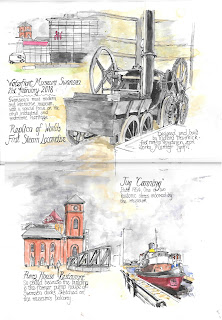
There aren't as many images this time, only 4. However
I did think a lot more carefully about how I was going to use them. One of the
things that links them together is making the Trevithick locomotive the obvious
'star', being that much bigger than the other images on the double page. I also
used colour to link them. My scanner has a problem with turning blues into
greys - the glass of the building at the top left is actually blue-green, and
the skies on the bottom are more purple grey, but even allowing for that you
can still see the way that the colours combine and leak into each other. The
only spaces I deliberately left as bare paper were the areas I knew I was going
to write my captions in. There's another point as well. Many years ago I taught
myself calligraphy, and for these sketches I made the conscious decision to
write in Italic for the headings, and foundation basic for the captions
themselves, and again, at the moment I'm thinking that they add a little bit of
class to the sketch.
Now, if I look back on the Glynn Vivian sketches, I still think they're not bad
in any way. However, I think that this double page sketch is such an
improvement, and for me very much a pointer for a way forward for the
future.
There are many free tutorials online, which you can
find if you use google or another search engine.Then there are a number of good
books which can help you develop your skills. A quick search on Amazon will
bring up lists of titles, and you can read the online reviews to help you
decide which one you think will be most helpful to you at this stage. I found
Marc Taro Holmes' "The Urban Sketcher" was helpful getting me
started.
I don’t know if you’re likely to find a specifically
urban sketching class or course, but chances are there is a course available
fairly locally in Life Drawing. Although not exactly the same as urban
sketching, following a life drawing course will definitely help you improve
your technique.
*
What do I do with my finished sketches?
Whatever you like. Personally, I usually keep mine.
They’re a nice record of progress. I also share mine – usually digitally. I
post most of my sketches on Pinterest, on the South Wales Urban Sketchers’ Facebook
page, and on my blog, but there are other places you could do so in cyberspace.
Flickr comes to mind.


















